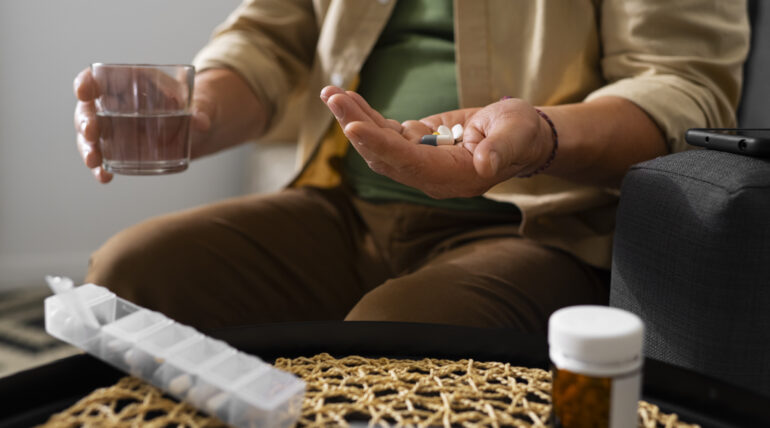
As a psychiatrist in Morris, IL working with Crossroads Counseling Services, I help clients explore how stimulant medications can support their treatment. For some, stimulants make it possible to focus, regulate energy, and manage daily responsibilities in a way that feels less overwhelming. For others, they provide the stability needed to fully engage in therapy or rebuild healthy routines.
Medication management, in my view, is never just about writing a prescription. It’s about understanding each person’s history, listening carefully to their goals, and making adjustments along the way.
Stimulants can be a powerful tool, but they work best when integrated into a broader plan; one that includes therapy, healthy coping strategies, and ongoing collaboration. My role is to make sure medication is not an isolated solution, but a piece of a thoughtful, individualized approach to healing and long-term wellness.
What Goes on in a Stimulant-Focused Session?
When I meet with a patient to explore stimulant medications, most often for ADHD, but sometimes for other focus– or mood-related concerns, I see the session as a partnership. The process isn’t about handing over a prescription; it’s about truly understanding what’s happening in daily life and making decisions together.
Starting With Understanding
We begin by looking closely at your day-to-day experience. When does focus come easily? When does it fade? Are there times when energy feels steady, and other moments when it crashes? I want to hear about what feels overwhelming, what feels manageable, and where you’d like to see change.
Bringing in Medication Thoughtfully
From there, we consider how stimulant medication may help. Stimulants are not a “one-size-fits-all” tool; they can bring clarity, sharper focus, steadier energy, or more balanced emotional regulation, but only when carefully matched to your unique needs. My role is to help identify whether a stimulant makes sense, and if so, how to use it safely and effectively as part of your care.
Tuning and Tweaking Along the Way
Medication management is rarely a straight line. We check in regularly to see what’s working, what feels off, and how your overall wellbeing is shifting. Adjustments, whether in dosage, timing, or the type of stimulant, are part of the process. It’s a collaborative, ongoing journey, not a one-time decision.
Why Stimulants Can Be Game-Changers, When Well-Matched
Stimulants work by gently increasing the availability of dopamine and norepinephrine which are two key brain chemicals that help with attention, motivation, focus, and mood regulation. When the dosage and timing align with your needs, they can feel like:
- Filtering through the noise: “I can finally start a task and stick with it long enough to actually feel productive.”
- Calming the inner restlessness: “My mind slows down just enough to help me notice my emotions rather than get swept away by them.”
- Opening space for therapy: Once focus is steadier or racing thoughts quiet even a little, sessions feel more grounded and connected.
Integrating Medication as Part of a Whole-Person Plan
I want to be clear: stimulant medication is a tool, not a fix-all. When I talk with clients about it, I emphasize that the goal isn’t to medicate away who they are, but to create the conditions where they can show up more fully in their lives.
A Focus Enhancer
For many people, stimulants help quiet the mental clutter that makes it difficult to stay on task. Instead of thoughts scattering in a dozen directions, there’s more capacity to follow through; whether it’s finishing work, keeping up with daily responsibilities, or simply feeling present in a conversation.
An Emotional Anchor
Stimulants can also reduce the internal restlessness that often fuels stress or emotional overwhelm. By calming that undercurrent, they make it easier to respond thoughtfully instead of reacting impulsively, creating a steadier foundation for handling life’s challenges.
A Therapy Amplifier
Medication alone is rarely the full answer. Where stimulants really shine is in making therapy more effective. When focus is steadier and emotions are less chaotic, clients often find they can engage more deeply with new skills, insights, and coping strategies. Medication creates more solid ground for real change to take root.
An Adjustable Partner
One of the strengths of stimulant medication is its flexibility. Doses, timing, or even the type of medication can be adjusted to fit a client’s needs as they evolve. This adaptability means that medication isn’t a rigid solution, but a partner that can shift alongside growth, challenges, and new goals.
A Peek Inside My Practice
Here’s what this work looks like in real time.
Listening Beyond Symptoms
I don’t just look at checklists of ADHD or mood-related symptoms. I want to understand how daily life actually feels; when energy dips, what evenings look like, which tasks feel impossible, and where life feels “stuck.” These details shape how we approach medication together, because the goal is always about improving real experiences, not just ticking boxes.
Side-Effect Check-Ins
Stimulants can bring side effects such as appetite changes, shifts in sleep, or occasional restlessness. We talk about these early and often, so adjustments can be made before they become disruptive. Staying proactive helps ensure that medication feels supportive rather than burdensome.
Collaborating With Therapists
I also work closely with our therapists at Crossroads Counseling because medication and therapy are most effective when they work hand in hand. Medication management may create the clarity or steadiness needed, while therapy builds the skills and insights that support long-term growth. Together, they reinforce each other, creating a fuller foundation for healing.
Final Thoughts
Navigating medication, especially stimulants, can feel tricky. But at Crossroads Counseling Services, it’s not about pulling a lever and hoping for the best. It’s about staying thoughtful, responsive, and connected, so you feel more in control – not less.
Whether you’re just considering stimulants or you’re already on them and curious about next steps, we’ll go through it together, with heart, expertise, and flexibility. Contact us today to learn more.
— Dr. James V. Dyers, D.O.
Sources
Farzam, Kamran, R. M. Faizy, and Afsheen Saadabadi. “Stimulants.” StatPearls, StatPearls Publishing, 2 July 2023, www.ncbi.nlm.nih.gov/books/NBK539896/.
Treatment for Stimulant Use Disorders: Updated 2021. Substance Abuse and Mental Health Services Administration (US), 1999. Treatment Improvement Protocol (TIP) Series, no. 33, Chapter 2—How Stimulants Affect the Brain and Behavior. National Center for Biotechnology Information, www.ncbi.nlm.nih.gov/books/NBK576548/.


